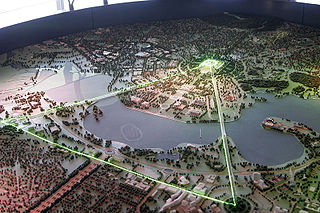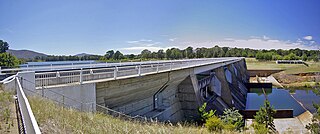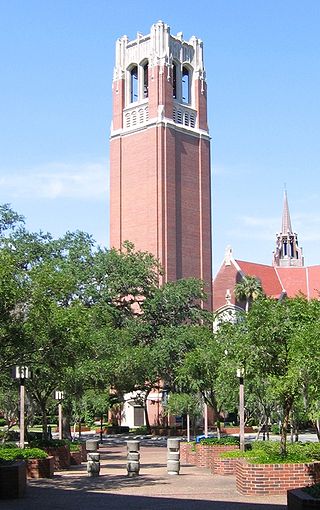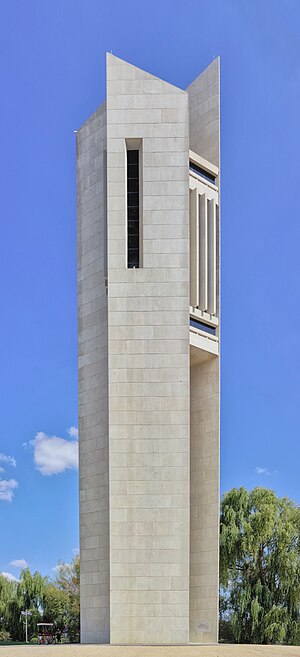
Walter Burley Griffin was an American architect and landscape architect. He designed Canberra, Australia's capital city, the New South Wales towns of Griffith and Leeton, and the Sydney suburb of Castlecrag.

Government House is the official residence of the governor-general of Australia. It is located in the suburb of Yarralumla, in the City of Canberra, in the Australian Capital Territory. The house is set amid 54 hectares of parkland. The house and associated grounds were added to the Commonwealth Heritage List on 22 June 2004.

Mount Ainslie is a hill with an elevation of 843 metres (2,766 ft) AHD that is located in the northeastern suburbs of Canberra, in the Australian Capital Territory, Australia. Mount Ainslie lies within part of the Canberra Nature Park.

Lake Burley Griffin is an artificial lake in the centre of Canberra, the capital of Australia. It was completed in 1963 after the Molonglo River, which ran between the city centre and Parliamentary Triangle, was dammed. It is named after Walter Burley Griffin, the American architect who won the competition to design the city of Canberra.

Barton is a suburb of Canberra, Australian Capital Territory, Australia. At the 2021 census, Barton had a population of 1,946 people.
The Peace Tower is a focal bell and clock tower sitting on the central axis of the Centre Block of the Canadian parliament buildings in Ottawa, Ontario. The present incarnation replaced the 55-metre (180 ft) Victoria Tower, after the latter burned down in 1916, along with most of the Centre Block; only the Library of Parliament survived. It serves as a Canadian icon and had been featured prominently on the Canadian twenty-dollar bill, directly adjacent to the depiction of Queen Elizabeth II, until the change to polymer.

The Albert Hall is a hall in Canberra, Australia, used for entertainment. It is on Commonwealth Avenue between Commonwealth Bridge and the Hotel Canberra in the suburb of Yarralumla.

The National Triangle, which is referred to as the Parliamentary Triangle, is the ceremonial precinct of Canberra, containing some of Australia's most significant buildings. The National Triangle is formed by Commonwealth, Kings and Constitution Avenues. Buildings within the National Triangle have been located and designed intentionally for visual effect, and those of national significance are popular tourist attractions.

Kings Park is a park in Canberra, Australia on the shore of Lake Burley Griffin.

St John the Baptist Church is an Australian Anglican church in the Canberra suburb of Reid in the Australian Capital Territory. The church is located at the corner of Anzac Parade and Constitution Avenue, adjacent to the Parliamentary Triangle, and is the oldest surviving public building within Canberra's inner city and the oldest church in the Australian Capital Territory. It has been described as a "sanctuary in the city", remaining a small English village-style church even as Australia's capital grew around it. Over time, it became a focal point for Australia's governors-general, politicians, public servants and military leaders, and has hosted royalty on numerous occasions.
The history of the Australian Capital Territory (ACT) as a separate administrative division began in 1911, when it was transferred from New South Wales to the Australian federal government. The territory contains Australia's capital city Canberra and various smaller settlements. Until 1989, it also administered the Jervis Bay Territory, a small coastal region.

The bourdon is the heaviest of the bells that belong to a musical instrument, especially a chime or a carillon, and produces its lowest tone.

Queen Elizabeth II Island, formerly Aspen Island, is an artificial island located within Lake Burley Griffin, in Canberra, Australian Capital Territory, Australia. It lies within the Parliamentary Triangle.

Scrivener Dam is a concrete gravity dam that impounds the Molonglo River in Canberra, Australian Capital Territory. The dam creates Lake Burley Griffin, which was established for recreational and ornamental purposes. Named in honour of surveyor Charles Scrivener, the dam was officially inaugurated on 20 September 1963 and the official filling of the lake commemorated on 17 October 1964 by the Prime Minister, Robert Menzies.

Blundells Cottage is a heritage-listed six-roomed stone cottage located on the northern shore of Lake Burley Griffin, in Canberra, Australia. The cottage was built by George P. Campbell in about 1858 for his ploughman William Ginn on the original Molonglo River floodplain. Ginn lived there with his family until 1874 and then Flora and George Blundell moved in and remained there until about 1933. Flora was a midwife and George a bullock driver for Campbell. In 1913, the Duntroon estate was acquired by the Commonwealth of Australia to form part of the new Federal Capital Territory, although the Blundells continued to live there. Then, Harry and Alice Oldfield moved to the cottage in 1933.

The Century Tower is a 157-foot-tall (48 m) bell tower containing a carillon in the center of the University of Florida campus in Gainesville, Florida, United States.
The National Capital Authority (NCA) is a statutory authority of the Australian Government that was established to manage the Commonwealth's interest in the planning and development of Canberra as the capital city of Australia.

Cameron Chisholm Nicol (CCN) is an Australian multi-disciplinary architecture practice. Established in Perth in 1884 by James William Wright, the firm has operated continuously in Western Australia since that time. The Brisbane office was opened in 1986. The two offices are no longer linked, and operate as separate entities.
Lyn Fuller is the national carillonist of Australia.

The High Court of Australia building is located on the shore of Lake Burley Griffin in Canberra's Parliamentary Triangle. It has been the permanent home of the High Court of Australia since 1980. The High Court building was designed between 1972 and 1974 by the Australian architect Christopher Kringas (1936–1975) – a director of the firm Edwards Madigan Torzillo and Briggs – who is commemorated by a plaque in the public hall.























